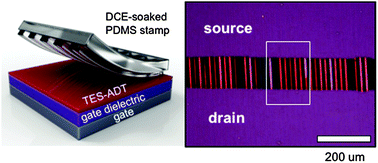Unified film patterning and annealing of an organic semiconductor with micro-grooved wet stamps†
Abstract
A unified patterning and annealing approach was successfully demonstrated for 5,11-bis(triethylsilylethynyl)-anthradithiophene (TES-ADT) films spun-cast on polymer-treated SiO2 dielectrics. First, rubbery polydimethylsiloxane (μ-PDMS) stamps with microscale periodic grooves were swollen in 1,2-dichloroethane and then softly placed onto amorphous-like TES-ADT films. In this case, the film sides physically in contact with the wet stamps were quickly absorbed into the PDMS matrix while the non-contact area formed highly-ordered phases by the solvent-annealing effect. The resulting patterns of TES-ADT contained discernable crystallites, where the grain sizes drastically decreased and their shapes transformed from spherulites to optically featureless ones with a decreasing line width from 100 to 2.5 μm. Unlike ordinary systems containing spherulitic domains, the 2.5 μm line-confined TES-ADT patterns contained layer-stacked crystallites but an optically invisible grain boundary, yielding an unexpectedly high field-effect mobility of 2.60 cm2 V−1 s−1 in organic field-effect transistors (OFETs), with narrow deviations less than 8% (averaged from 42 devices). The results suggest that the well π-overlapped grains and their smooth connections are key factors to achieve high performance multi-array OFET applications.


 Please wait while we load your content...
Please wait while we load your content...